by
Friedrich Diestelkamp
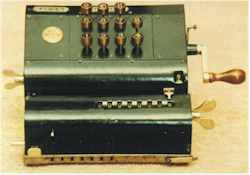 After a while every collector gives his collection a special
motto. Is the collection at first to be described very generally with "old
mechanics," so after a while he wants to change to a special company, construction or
color. For calculators, for example, he may concentrate in Brunsviga calculators with
crank or slide rules, or slide adders. Here I'd like to introduce the collection area of
"Non-decimal Calculators", which is very fascinating and offers many aspects.
Nearly all principles of construction are represented, from simple slide adders to
machines with pin wheel. This presentation does not show all aspects, but it shall give an
overview and make a proposal for a complete independent collection area. Intentionally I
don't discuss abacus, slide rules and tables. After a while every collector gives his collection a special
motto. Is the collection at first to be described very generally with "old
mechanics," so after a while he wants to change to a special company, construction or
color. For calculators, for example, he may concentrate in Brunsviga calculators with
crank or slide rules, or slide adders. Here I'd like to introduce the collection area of
"Non-decimal Calculators", which is very fascinating and offers many aspects.
Nearly all principles of construction are represented, from simple slide adders to
machines with pin wheel. This presentation does not show all aspects, but it shall give an
overview and make a proposal for a complete independent collection area. Intentionally I
don't discuss abacus, slide rules and tables. |
|
| From its very beginning, the main task of the "science of calculating" was to calculate prices, count money, handle weights, distances and times. Europeans were always used to special non-decimal units, but today we are surprised to find that not all calculations are decimal. However, every day we see units such as the "dozen," the circle with its 360 degrees, and the "pair" which is the smallest unit larger than one. On our Earth the special units are as many as the nations using them. Moreover, unit systems are combined so that two or more bases are used: In the lower values it is usual to find fractions of base 12, while in the upper values the base 10 is generally used. This belongs to the educated mathematicians, thinking in bigger amounts. | |
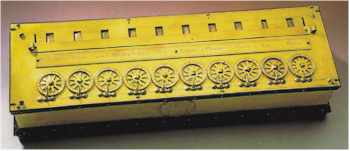 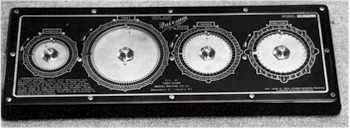 |
In 1644 Blaise Pascal announced an adding machine for French currency. His father was responsible for taxation of his fellow citizens, what ever was very stimulating. The design of his Pascaline was very practical, so it was used up to the sixties in our century! The stylus was used all the way up to the end of mechanical calculators. |
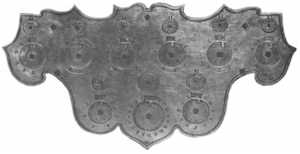 The Italian Burattini built up his calculator
with 18 disks in 1659. It was a curious monster, more likely a shield out of Middle Ages.
The disks were distributed decoratively all over the surface, and he too did the input
with a stylus. For each unit he used two coupled disks, but there was no carry to the next
unit, so the user had to do the carry by his own. The first unit had the base 12, the next
base 20. Another two-disk-unit counts to 7, I can't explain that. The Italian Burattini built up his calculator
with 18 disks in 1659. It was a curious monster, more likely a shield out of Middle Ages.
The disks were distributed decoratively all over the surface, and he too did the input
with a stylus. For each unit he used two coupled disks, but there was no carry to the next
unit, so the user had to do the carry by his own. The first unit had the base 12, the next
base 20. Another two-disk-unit counts to 7, I can't explain that. |
|
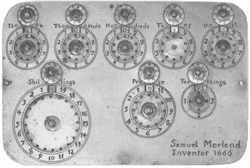 The English inventor Morland constructed at first in 1664 a decimal
calculator, which was similar to the PASCAL machine. But in 1666 he showed a new
calculator for English currency, which was very similar to the Burattini device. He as
well uses for each unit two coupled disks and had no carry to the next unit. But the parts
of his apparatus seem to be well sorted. The English inventor Morland constructed at first in 1664 a decimal
calculator, which was similar to the PASCAL machine. But in 1666 he showed a new
calculator for English currency, which was very similar to the Burattini device. He as
well uses for each unit two coupled disks and had no carry to the next unit. But the parts
of his apparatus seem to be well sorted. |
|
In 1679 Leibniz made studies to binary calculation. He described a Digital Adder, which has been reconstructed and can be seen in the "Deutsches Museum“ in Munich, Germany. This device has an astonishing similarity to the binary adder of modern digital IC in our computers! A former employee of Philipp Matthäus Hahn, Jacob Auch, constructed, after leaving the Hahn workshop in about 1790, an adding machine. |
|
The only known ternary calculator has been build up and presented by the English Thomas Fowler in 1840. It is said that his device had been functional. But unfortunately there is only one not so clear picture, so we don’t know how it worked and why he used base 3. |
|
Again an English inventor, Guthrie, constructed a calculator for his complicated currency. In 1890 Guthrie patented his slide adder named G.E.M, produced by Arter, Dixon & Co in series. It was made of wood and paper card, so it was not so robust for daily use. |
|
| The French Troncet constructed 1889, shortly before Guthrie, his Arithmographe. As I know this calculator was only decimal at first. Later on he made a variant for English currency. It is the same principle of slide adder as that of Guthrie. But Troncet manufactured it with metal and combined it with tables for multiplication. This device has been produced for a long time and today we know a lot of items. I guess that is the reason why American collectors call this kind of calculators "TRONCET-TYPE“. But I’m not so happy with that since this type of calculator was invented 200 years earlier by Perrault! | |
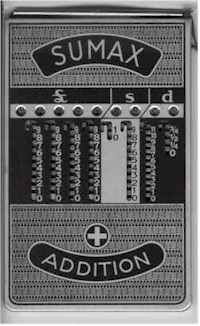 By
1900 there were a lot of calculators with nearly all construction principles on the market
usable for currencies, weights and dimensions. Nearly all companies produced such
variants, especially as machines could be changed very simply from decimal to non decimal
operation. In addition, those machines could be used for decimal calculation by ignoring
or covering lowest digits. So the variation in calculating bases was the state of the art.
Nevertheless there were a lot of possibilities to enhance production or calculation: So we
can find in patent literature a lot of ideas for better carry, direct multiplication etc. By
1900 there were a lot of calculators with nearly all construction principles on the market
usable for currencies, weights and dimensions. Nearly all companies produced such
variants, especially as machines could be changed very simply from decimal to non decimal
operation. In addition, those machines could be used for decimal calculation by ignoring
or covering lowest digits. So the variation in calculating bases was the state of the art.
Nevertheless there were a lot of possibilities to enhance production or calculation: So we
can find in patent literature a lot of ideas for better carry, direct multiplication etc. |
|
 Digital computer technology works
binary (see Leibniz). Combining 3 or 4 bits we get octal or hexadecimal (sedecimal) data
structures, which uses the storage capacity of computers better than decimal structures.
And data are better to read for (Assembler-) programmers. But at first there was no adding
device, so programmers had to use their head again. It was necessary to develop a
calculator which could handle addition and subtraction for this new structures. Beginning
of 1967 the ADDIATOR company registered the trademark HEXADAT which was produced several
years. About the same time the OCTADAT was produced, but there were not so many computers
using octal data format. Known as well is an IBM HEXADECIMAL ADDER, that obviously was
produced in the late 60's. But these adders were knocked out when Texas Instruments
produced his TI22 at the beginning of the 70's, which could handle binary, octal,
decimal and hexadecimal base if needed. Shortly later the legendary and well known TI
Programmer was announced Digital computer technology works
binary (see Leibniz). Combining 3 or 4 bits we get octal or hexadecimal (sedecimal) data
structures, which uses the storage capacity of computers better than decimal structures.
And data are better to read for (Assembler-) programmers. But at first there was no adding
device, so programmers had to use their head again. It was necessary to develop a
calculator which could handle addition and subtraction for this new structures. Beginning
of 1967 the ADDIATOR company registered the trademark HEXADAT which was produced several
years. About the same time the OCTADAT was produced, but there were not so many computers
using octal data format. Known as well is an IBM HEXADECIMAL ADDER, that obviously was
produced in the late 60's. But these adders were knocked out when Texas Instruments
produced his TI22 at the beginning of the 70's, which could handle binary, octal,
decimal and hexadecimal base if needed. Shortly later the legendary and well known TI
Programmer was announced |
|
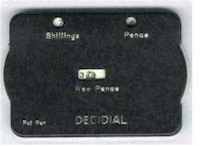 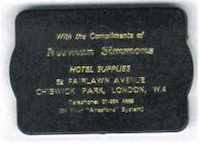 The list of calculators with non-decimal base is long and could be
extended if somebody is engaged in this sector of calculators. There was nearly no company
daring not to follow this trend. But most of currencies and weight systems have been
changed to decimal. And when English currency became decimal (February 15th 1971) there
was – as a good-bye – a small calculator with 2 disks to convert old to new
shillings. That was the DECIDIAL, but I would not say that this was a real calculator.
With this, the end of mechanical non-decimal calculators has been reached. The list of calculators with non-decimal base is long and could be
extended if somebody is engaged in this sector of calculators. There was nearly no company
daring not to follow this trend. But most of currencies and weight systems have been
changed to decimal. And when English currency became decimal (February 15th 1971) there
was – as a good-bye – a small calculator with 2 disks to convert old to new
shillings. That was the DECIDIAL, but I would not say that this was a real calculator.
With this, the end of mechanical non-decimal calculators has been reached. |
|
|
|
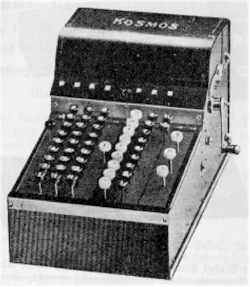 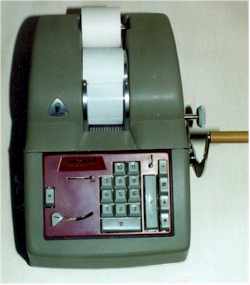 |
|
| Pictures: PASCAL, France ca. 1650. (s. text) (Postcard: Staatlicher Mathematisch-Physikalischer Salon Dresden) BURATTINI, Italy 1659. (s. text) (Museum Florenz, book:"Storia Del Calcolo Automatico" Morland, England, 1666. (s. text) (Museum Florenz, book:"Storia Del Calcolo Automatico" MATADOR, Grimme, Natalis & Co, ca. 1905. Special construction as column adder. Counts Shillings in lowest unit, other units are decimal. Additionally 4 x ¼ sh. (Picture with permission to Diestelkamp) KOSMOS, British Calculator Ltd. (Martin, p. 211) QUIXSUM, Precision Adding Machines, USA, ca. 1924. Disk adder with automatic carry for fractions, pence, shilling and pound. (Picture with permission to Diestelkamp) G1114 E, Brunsviga, Germany, ca. 60's: English currency (shilling, pound), switchable to only decimal. (Picture: Otto Stark) HEXADAT, Addiator, Germany, >1967. (sedecimal, s. text) (Picture: Diestelkamp) DECIDIAL, England, ca. 1970. (conversion of English currency old to new, s. text) (Picture: Diestelkamp) ADDFEET, Addiator, Germany, from 1958 on (s. text) (Picture: Diestelkamp) SUMAX STERLING, Addimult, Germany, ca. 1954. Literature (selection): Calculating Machines and Computers (Tweedale, 1990) Storia Del Calcolo Automatico (Soresini, 1977) Entwicklungsgeschichte des Computers (Vorndran, 1982) Die Rechenmaschinen und ihre Entwicklungsgeschichte (Martin, 1925 / 1936) |
|
| Copyright © Friedrich Diestelkamp, Munich,
Germany, in March 2000 For more information: www.addiator.de and www.rechnerlexikon.de All rights reserved |
|